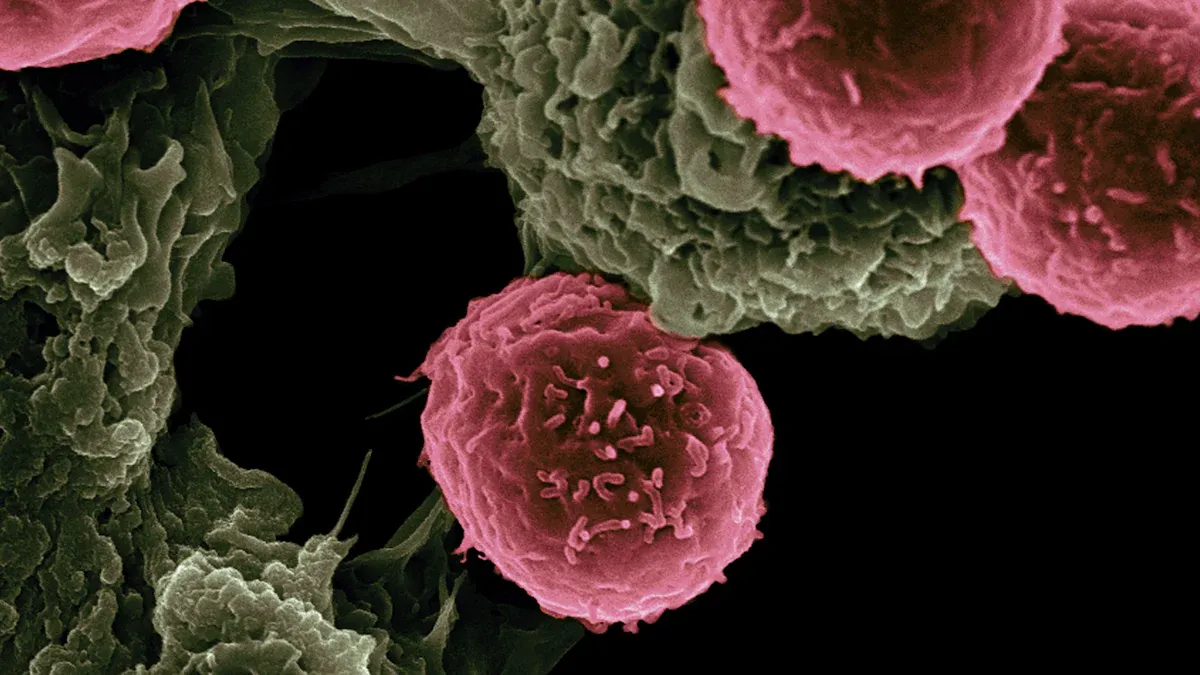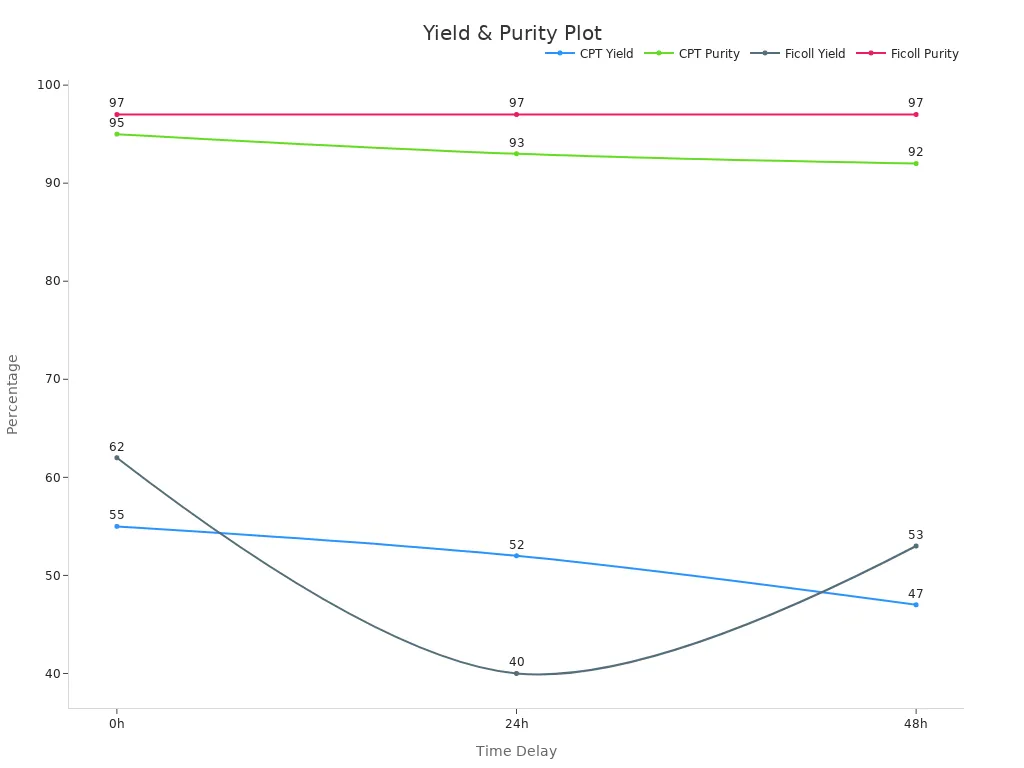
Human PBMCs, or Peripheral Blood Mononuclear Cells, are a critical group of immune cells that circulate in your bloodstream. These cells include lymphocytes, monocytes, and dendritic cells, each playing a unique role in defending your body. PBMCs protect you by identifying and neutralizing harmful pathogens, like bacteria and viruses, while also maintaining immune balance.
Research shows PBMCs remain stable over time, with cell viability above 85% in most samples. Additionally, their gene expression can adapt quickly. For instance, TNFα expression increases by over threefold within hours. Such versatility highlights their importance in regulating immune responses.
Composition of Human PBMCs

Lymphocytes: T Cells, B Cells, and NK Cells
Lymphocytes are a vital component of human PBMCs. They include T cells, B cells, and natural killer (NK) cells, each with distinct roles in immunity. T cells help regulate immune responses and directly attack infected cells. B cells produce antibodies, which neutralize harmful pathogens. NK cells, on the other hand, target and destroy abnormal cells, such as those infected by viruses or cancerous cells.
Interestingly, some lymphocytes in human PBMCs, identified as CD3+CD19+ cells, exhibit dual functionality. These cells can act like both T cells and B cells. They respond to threats through T-cell receptor (TCR) and B-cell receptor (BCR) signaling pathways. This dual role allows them to participate in both humoral and cellular immune responses. For example, they bind antigens more effectively than conventional B cells and produce interferon-gamma (IFN-γ) at levels similar to T cells.
Monocytes and Their Immune Functions
Monocytes are another key group within human PBMCs. These cells patrol your bloodstream, searching for signs of infection or tissue damage. Once they detect a problem, they migrate to the affected area and transform into macrophages or dendritic cells. Macrophages engulf and digest pathogens, while dendritic cells present antigens to other immune cells.
Monocytes also release cytokines, which are signaling molecules that help coordinate the immune response. By doing so, they ensure that your body reacts effectively to infections or injuries.
Dendritic Cells and Their Role in Antigen Presentation
Dendritic cells are professional antigen-presenting cells (APCs) within human PBMCs. They play a crucial role in activating T cells by presenting antigens on their surface. Research shows that dendritic cells are the only APCs capable of activating both CD4+ and CD8+ naïve T cells. Their efficiency comes from their ability to slow down antigen digestion, which increases the availability of peptides for MHC loading.
|
Evidence Description |
Findings |
Methodology |
|---|---|---|
|
Dendritic cells activate both CD4+ and CD8+ naïve T cells. |
They are the most efficient APCs due to reduced antigen digestion rates. |
Flow cytometry-based assays and T cell proliferation analysis. |
|
Antigen presentation assay details. |
T cells co-cultured with pulsed dendritic cells showed significant proliferation. |
Co-culture experiments analyzed by flow cytometry. |
These cells ensure that your immune system recognizes and responds to threats effectively, making them indispensable in immunity.
Isolation of Human PBMCs
Sources of PBMCs: Peripheral Blood and Bone Marrow
Human PBMCs can be isolated from two primary sources: peripheral blood and bone marrow. Peripheral blood is the most common source due to its accessibility and minimal invasiveness. Bone marrow, on the other hand, provides a richer environment for immune cells but requires a more invasive procedure.
The yield and purity of PBMCs can vary depending on the source and isolation method. For example, studies show that the standard Ficoll method achieves a higher yield and purity compared to CPT (Cell Preparation Tube) methods. The table below highlights these differences:
|
Isolation Method |
Time Delay |
Yield (%) |
Purity (%) |
Viability (%) |
|---|---|---|---|---|
|
CPT |
0h |
55 |
95 |
62 |
|
CPT |
24h |
52 |
93 |
51 |
|
Standard Ficoll |
0h |
62 |
97 |
64 |
|
Standard Ficoll |
24h |
40 |
97 |
44 |

Ficoll Overlay Technique for PBMC Isolation
The Ficoll overlay technique is a widely used method for isolating PBMCs. This process involves layering blood over a Ficoll-Paque solution and centrifuging it to separate cells based on density. PBMCs form a distinct layer between plasma and Ficoll, making them easy to collect.
Studies emphasize the importance of proper handling during this process to ensure consistent results. For instance, one study found that using Ficoll correctly can achieve a purity of up to 97% with minimal variability. The table below compares different incubation methods for PBMC isolation:
|
Method |
Purity (%) |
Statistical Significance |
|---|---|---|
|
M1 (3 hours incubation) |
87 ± 2.31 |
P < 0.0001 |
|
M2 (overnight incubation) |
95.9 ± 1.38 |
P > 0.05 |
|
M3 (MACS method) |
95.4 ± 1.35 |
P > 0.05 |
Immunomagnetic Separation Methods
Immunomagnetic separation is another advanced technique for isolating PBMCs. This method uses magnetic beads coated with antibodies to target specific cell types. Positive sorting isolates cells by binding them to the beads, while negative sorting removes unwanted cells, leaving the desired population untouched.
Research shows that negative sorting maintains cell viability and does not affect activation markers like IL-2R (CD25). In contrast, positive sorting can reduce viability and activation capacity, especially after stimulation. The table below summarizes these findings:
|
Sorting Method |
Effect on Cell Viability |
Effect on Activation Status |
|---|---|---|
|
Positive Sorting (CD14+ Monocytes) |
Reduced viability after LPS stimulation |
Reduced activation and proliferation capacity |
|
Positive Sorting (CD4+ and CD8+ T cells) |
Maintained viability |
Activation by ligation of CD4 and CD8 molecules |
|
Negative Sorting |
Maintained viability |
No effect on expression of IL-2R (CD25) |
This method is particularly useful when you need highly specific cell populations for research or therapeutic applications.
Applications of Human PBMCs in Research and Medicine


Role in CAR-T Cell Therapy Development
Human PBMCs play a pivotal role in advancing CAR-T cell therapy, a groundbreaking treatment for certain cancers. These cells serve as the starting material for generating CAR-T cells, which are engineered to target and destroy cancer cells. You might wonder how effective PBMCs are in this process. Studies reveal impressive results:
-
After 11 days of culture, 1 × 10^7 frozen PBMCs can produce at least 1.48 × 10^9 mesoCAR-T cells, with over 30% CAR+ cells.
-
Cytotoxicity tests show mesoCAR-T cells derived from fresh and cryopreserved PBMCs perform similarly. At an effector-to-target ratio of 4:1, their cytotoxicity ranges between 91.02%-100.00% and 95.46%-98.07%, respectively.
-
Even at a lower ratio of 2:1, no significant difference in cytotoxicity is observed.
These findings highlight the reliability of PBMCs in producing effective CAR-T cells, even after long-term storage.
Use in Drug Testing and Toxicity Studies
PBMCs are invaluable in drug testing and toxicity studies. They provide a human-relevant model to evaluate how drugs interact with immune cells. For example, researchers have tested the drug Quinacrine on PBMCs to assess its toxicity. The table below summarizes the findings:
|
Sample Type |
Drug Tested |
Toxicity Level |
PBMC Response |
|---|---|---|---|
|
Leukemia Samples (12) |
Quinacrine |
Low |
Active |
|
Normal Mononuclear Cells (4) |
Quinacrine |
Low |
Active |
These results demonstrate that PBMCs respond actively to Quinacrine, even at low toxicity levels. This makes them a reliable tool for predicting immune responses to new drugs.
Biomarker Discovery and Immune Monitoring
PBMCs are essential for identifying biomarkers and monitoring immune health. Biomarkers are measurable indicators of biological processes or diseases. By analyzing PBMCs, you can uncover biomarkers that reveal immune activity, disease progression, or treatment effectiveness. For instance, researchers often measure cytokine levels in PBMCs to monitor immune responses during infections or therapies. This approach helps tailor treatments to individual patients, improving outcomes.
PBMCs also enable long-term immune monitoring. Their stability and adaptability make them ideal for tracking changes in immune function over time. This is particularly useful in chronic diseases or during prolonged treatments.
Human PBMCs are indispensable in understanding and advancing immunology. Their diverse composition—lymphocytes, monocytes, and dendritic cells—enables them to perform critical immune functions. Isolation techniques like the Ficoll overlay and immunomagnetic separation ensure you can obtain high-purity PBMCs for research or therapeutic use.
Their applications span a wide range of fields:
-
Thousands of studies have utilized PBMCs in clinical research over the past 50 years.
-
They are vital for CAR-T cell therapy, drug development, and immune response analysis.
-
PBMCs contribute to biomarker discovery, patient stratification, and rare disease research.
By leveraging PBMCs, you can unlock new possibilities in immunology and develop innovative treatments that transform healthcare.
FAQ
What are PBMCs used for in medical research?
PBMCs help researchers study immune responses, test new drugs, and develop therapies like CAR-T cell treatments. Their adaptability and stability make them ideal for experiments that require human immune cells.
How do you store PBMCs for future use?
You can store PBMCs by cryopreserving them in liquid nitrogen. This method maintains their viability and functionality for years, allowing you to use them in long-term studies or therapeutic applications.
Are PBMCs the same as white blood cells?
Not exactly. PBMCs are a subset of white blood cells that include lymphocytes, monocytes, and dendritic cells. They exclude granulocytes like neutrophils, which are also part of white blood cells.
Can PBMCs be used to study autoimmune diseases?
Yes! PBMCs are valuable for studying autoimmune diseases. They help you analyze immune cell behavior, cytokine production, and genetic markers, providing insights into disease mechanisms and potential treatments.
Is PBMC isolation a complicated process?
Not really. Techniques like the Ficoll overlay method or immunomagnetic separation make PBMC isolation straightforward. With proper training and equipment, you can achieve high-purity samples for your research.
Post time: 2025-04-10 13:41:05



